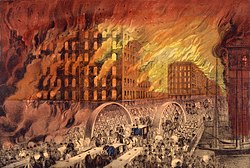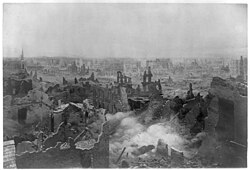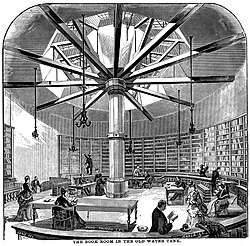
The Great Chicago Fire of 1871 was an enormous urban fire which swept through the city of Chicago between the 8th of October 1871 when it started on the West Side of the city and the 10th of October, by which time it had spread across much of the city. The fire was one of the worst municipal disasters in the history of the United States. Over three square miles of land in the center of the city were laid waste, destroying approximately 17,000 houses and leading to the deaths of roughly 300 people. It is estimated that 100,000 out of the city’s 300,000 people were left homeless as a result of the fire. Far from leading to depopulation in Chicago, the great fire spurred urban renewal and growth as the city was redeveloped in the 1870s. Chicago consequently became for a time the fastest growing city in human history, with a population that ballooned between 1871 and 1900 from roughly 300,000 to 1.7 million people.[1]
Chronology of eventsChronology of events

The lands along the southern shores of the Great Lakes had been inhabited by Native American groups such as the Huron and Algonquians in the seventeenth and eighteenth centuries. Very tentative steps to establish some settlements here had been made by the government of the United States in the 1790s and 1800s, but it was only in the aftermath of the War of 1812 that extensive migration into the area began. Chicago was founded as a small settlement here in the late 1810s. It remained a relatively minor town until 1837 when it was granted a municipal charter. Thereafter the town began rapidly expanding into a city. From just over 4,000 souls in 1840, it grew to nearly 30,000 by 1850, to 112,000 in 1860 and then just short of 300,000 inhabitants by 1870. But like all cities which expanded at such a rate in the nineteenth century, the city was littered with fire hazards as tenements made out of wood and other flammable substances were built in close proximity to one another, all at a time when open fires were still used everywhere to heat homes, cook meals and provide lighting.[2]
The great fire came about owing to a perfect storm in the city. It was a particularly dry autumn in this part of North America and this, combined with the manner in which the city had developed over the previous decades, turned the city into a tinder box. The exact origins of the fire have never been concretely determined, although the general area seems to have been around the barn of the O’Leary household on DeKoven Street on the southwest side of the city. A legend holds that a cow belonging to the O’Learys knocked over a lantern which ignited, but there is nothing to substantiate this. What is clear is that the fire quickly spread after it started about 8:30 p.m. on the evening of the 8th of October and by the early hours of the 9th was out of control. By 2:30 a.m. the city courthouse was alight and Chicago’s citizens would have heard the great bell there come crashing down. In the hours that followed it spread across the Chicago River and lit a railway car full of kerosene, compounding the conflagration. By the time rain arrived late on the 9th much of the city was destroyed. As the fire petered out on the 10th it was revealed that 17,000 homes and buildings had been destroyed or badly damaged causing the equivalent of over four billion dollars worth of damage adjusted for inflation. Eventually the death toll was estimated to be around 300.[3]
Resulting migrationResulting migration

The fire left one-third of Chicago’s population of 300,000 people homeless. This might have led to a mass exodus from the city, but in fact Chicago entered a period known as the Great Reconstruction, whereby a safer, better-built city was created. It also benefited from an enormous amount of help from the outside world. The railway lines were left intact and in the weeks that followed aid in the form of food, building material and everything else that was needed poured in from the East Coast. In fact the charity came from even further afield. Huge book donations came all the way from England and these facilitated the establishment of Chicago Public Library in 1873 in the shell of what had been the city's old water tower.[4]
This urban renewal led to hundreds of thousands of people streaming west towards Chicago in the decades that followed. By 1880 the population of the city had expanded to half a million people, but the real period of growth was during the 1880s when the number of Chicagoans more than doubled to 1.1 million people. By 1900 population had reached 1.7 million, with increases to 2.2 and 2.7 million people respectively by 1910 and 1920. This made Chicago the fastest growing city in human history by the end of the nineteenth century.[5]
Demographic impactDemographic impact
The demographic impact of the fire varied widely. Many of those who were arriving to Chicago in the 1870s, 1880s, and 1890s were people who were born in Europe and had arrived to cities like New York and Boston first, before heading on further westward to the Great Lakes region. For instance, the Irish settled in vast numbers in the south side of Chicago, a part of the city which is still dominated by Irish-American communities in many parts of it today.[6] The city also became a hub of Italian settlement. By 1930 nearly 75,000 Italian-born migrants were living in Chicago and this was augmented by second and third generation Italian-Americans. Today it is estimated that upwards of half a million of Chicago’s 2.7 million people are of some level of Italian descent.[7] Chicago also became a center for Scandinavian settlement in the aftermath of the great fire, with tens of thousands of Norwegians,[8] Swedes[9] and Danes[10] living here by 1900. In this capacity the city also acted as a gathering point for many Scandinavian and north Germanic and Polish migrants who subsequently travelled out further west again and settled in the Midwest, particularly North Dakota, South Dakota, Minnesota and Wisconsin.
See alsoSee also
Explore more about the Great Chicago FireExplore more about the Great Chicago Fire
- 1870 United States Federal Census at MyHeritage
- 1880 United States Federal Census at MyHeritage
- Illinois Marriages, 1763-1900 at MyHeritage
- Illinois Deaths, before 1916 at MyHeritage
- It Is Well With My Soul: Finding Ancestors Amid the Rubble of Disaster and Misfortune at Legacy Family Tree Webinars
References
- ↑ https://www.pbs.org/wgbh/americanexperience/features/chicago-fire/
- ↑ https://www.pbs.org/wgbh/americanexperience/features/chicago-timeline/
- ↑ https://www.history.com/topics/natural-disasters-and-environment/great-chicago-fire
- ↑ https://education.nationalgeographic.org/resource/chicago-fire-1871-and-great-rebuilding/
- ↑ https://www.biggestuscities.com/city/chicago-illinois
- ↑ http://www.encyclopedia.chicagohistory.org/pages/652.html
- ↑ http://www.encyclopedia.chicagohistory.org/pages/658.html
- ↑ http://www.encyclopedia.chicagohistory.org/pages/911.html
- ↑ http://www.encyclopedia.chicagohistory.org/pages/1222.html
- ↑ http://www.encyclopedia.chicagohistory.org/pages/363.html

